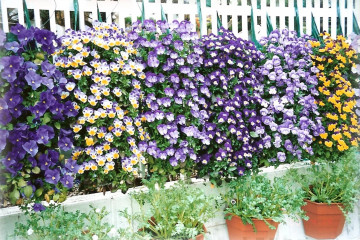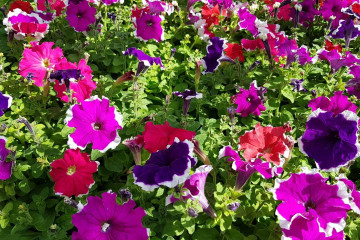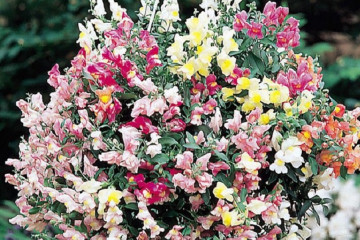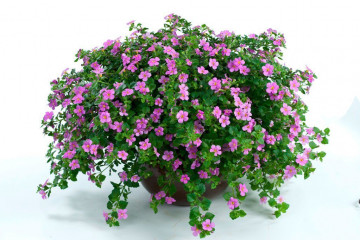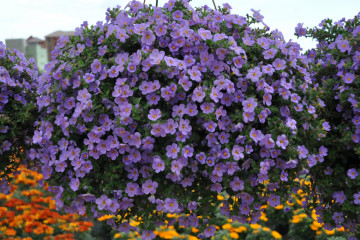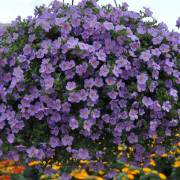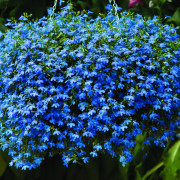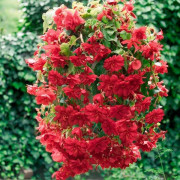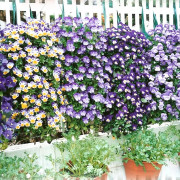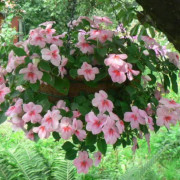How surfiniya differs from petunia - care and cultivation
Content:
Avid gardeners must be able to keep track of the most varied types of flowers that live on the site. It is necessary to create individual conditions for them. Some are less demanding, while others will have to tinker and learn how to care for them. Particular attention is paid to beautiful ampelous plants that can be placed in pots. One of them is surfinium (aka sulfinium).
Surfinia ampelous: care and cultivation at home
By providing ampelous sulfinia with attention and full care, you can enjoy lush and long flowering throughout the season. To grow a flower, as if from a picture, it is recommended to follow the basic rules.
Growing and caring for surfinia
You can grow surfini at home in 2 ways:
- 1 Method - growing seedlings.
The seeds are very small in size, therefore, when sowing, they are laid out in several pieces on moistened soil in pots, then covered with a film. The soil should not be allowed to dry out, therefore, regularly moisten it by irrigation from a spray bottle. Particular attention must be paid to the surrounding conditions: the room must be well lit and warm (from +20 degrees). For good germination, ensure that the seedlings are exposed to direct sunlight. After the first shoots, the roots are sprinkled with sand to prevent rotting. As soon as 2 full-fledged leaves grow, the seedlings are divided into different pots. Before planting in open ground, the seedlings are hardened, exposing them to the street for a short time. It is necessary to start from the 1st hour, gradually increasing the residence time.
- 2 Method - grafting.
At the beginning of autumn, a cutting about 10 cm long is cut from a large and healthy bush. It is rooted in fertile soil and a kind of greenhouse is created, covering the plant with a plastic bottle or container. With the appearance of the first two leaves on the handle, the greenhouse can be removed. By spring, a lush bush is formed, which is quite ready for life on the street.
This flower is very susceptible to external environmental conditions. In order for the plant to actively grow and develop, it must be located in a place where a sufficient amount of sunlight falls. When thinking about the location for hanging baskets and pots, you need to choose places with the following criteria:
- sunny side. It is desirable that the flower be in partial shade at noon;
- the presence of an artificial canopy, since the flower does not tolerate rain;
- flower pots are hung on the leeward side, protecting the surfinia from drafts.
The next moment, which is very important when caring for this flower, is the choice of soil. The land should be loose and fertile. Experienced growers advise growing surfinia in loam or sandy loam with a neutral or slightly acidic environment. To obtain a soil suitable for this flower, peat, vermicompost, turf are mixed in a ratio of 1: 1: 4. Vermiculite can be added to the finished mixture. It will make the soil mixture loose.
The soil can be fertilized before planting. To do this, apply:
- ready-made fertilizers containing potassium;
- organic feeding - mullein infusion or Vermistim.
Top dressing is necessarily accompanied by watering or spraying. They have a positive effect on foliage development and prolong the flowering period. The procedure is carried out once a week.
Surfinia loves frequent watering, but at the same time reacts extremely negatively to stagnant water. Therefore, before filling the pot with soil, it is recommended to lay a drainage 5 cm thick on the bottom.
The frequency of watering is determined by the season. In hot weather, it is better to moisten the soil daily, and on rainy and cool days, as the soil dries up. A flower planted in a pot is watered under the roots with settled warm water; for a plant in a pots, you can apply spraying from a spray bottle.
To give the bush a neat and compact shape, it is recommended to cut off its shoots. This is done between July and August. The lush shape and uniform development of surfinia is achieved by pinching the shoots as they reach 20 cm in length. Do not despair of a decrease in the intensity of development. The flower recovers its strength within a couple of weeks, after which it is ready to again delight its owner with an abundance of bright buds.
It should not be overlooked that, like any other plant, surfinia can get sick. A spider mite may appear on the plant. This is manifested in the appearance of yellowish dots and small cobwebs. When the first signs are found, it is necessary to treat the flower with soapy water. Treatment with specialized chemicals is quite effective - Actellik, Nero, Fitoverm.
The appearance of brown spots indicates the development of late blight. Then it is necessary to carry out treatment with preparations with a high concentration of copper.
The development of wet, gray or white rot is a consequence of violation of the rules of maintenance: stagnant water in the pot, cold environment, acidic soil. In this case, a complex treatment is carried out with organic preparations (for example, Fitosporin) and chemicals (for example, Maxim).
To overcome the whitefly, Aktara and Mospilan are used. The influence of this parasite is manifested in wilting and yellowing of foliage.
What is the difference between care during the flowering season as opposed to the dormant period
Despite the fact that surfiniya is a street resident, it dies during the first frost. It can only be saved by moving it into the house. Before that, all the foliage is cut off, leaving no more than 15 cm. Next, the pots and pots are moved to the balcony or loggia. Watering should be done much less frequently as the soil dries out. With the onset of spring, the flower is transferred back to the street.
How surfiniya differs from petunia
Surfinia ampelous is a hybrid of petunias. How surfiniya differs from petunia is clear only to experienced gardeners. Very often surfiniya is compared to ampelous petunia. However, surfinia differs from its parent in a number of advantages.
They can be distinguished by their abundant and luxurious flowering. Also, the difference lies in the fact that the buds of the surfinia hang down, and the inflorescence itself is endowed with dark or light eyes. Another difference is the smell. It smells good, and the aroma intensifies in the evening.
Surfinia hybrid of Japanese breeding petunia
This flower is the fruit of long experimentation by Japanese breeders. Back in the 1970s, Suntory was working to adapt the quivering petunia to a wide variety of weather conditions. As a result, a variety was bred, which was named "surfiniya". In a fairly short period of time, it gained worldwide popularity, and there were several reasons for this:
- the flower is quite resistant to adverse weather, or rather to rain and wind. However, you should not expose the flower to constant exposure to cold water and temperature;
- in comparison with petunia, it is less susceptible to diseases;
- long flowering period. It is also worth noting that it is more lush and active;
- variety of shades (white, pink, red, yellow, purple, etc.);
- the growing season is faster.
When purchasing surfinia for garden decoration, you should carefully study the rules of growing and care. Sulfinia ampelous care and cultivation at home for which it may seem difficult at first, grows into a lush and amazingly beautiful bush that looks like a bright waterfall of terry buds.






